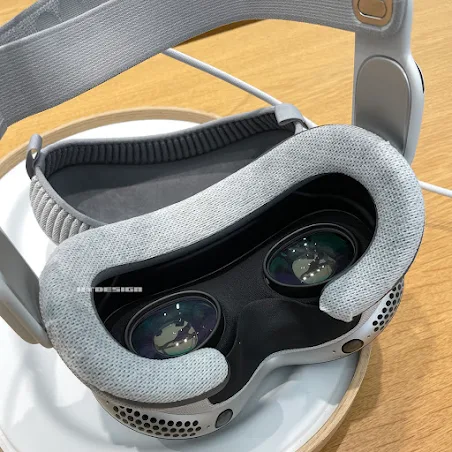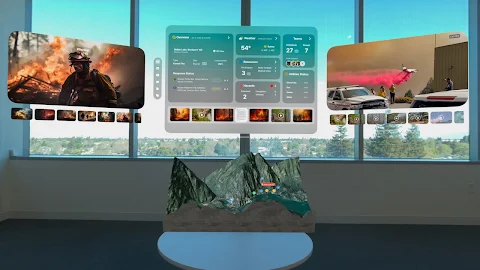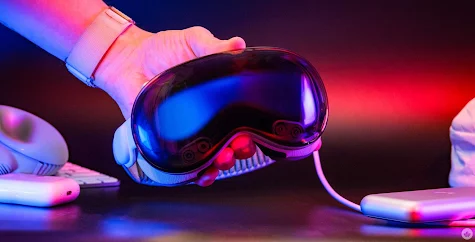Introduction
The tech world has been buzzing with excitement since Apple unveiled its latest groundbreaking product, the Apple Vision Pro. Touted as a "spatial computer," this device represents Apple's most ambitious step into the world of augmented reality (AR) and virtual reality (VR). In this comprehensive review, we will delve into the features, performance, user experience, and overall value of the Apple Vision Pro.
Design and Build Quality
Apple has always been known for its sleek, minimalist design, and the Vision Pro is no exception. The headset is crafted from lightweight aluminum and features a seamless glass front, giving it a futuristic aesthetic. The adjustable headband ensures a comfortable fit for various head sizes, while the soft, breathable fabric lining adds to the comfort, making it suitable for extended use.
The device also includes a unique external display that shows the user's eyes, allowing for a more natural interaction with others around them. This innovation addresses one of the main concerns with VR headsets: the isolation from the real world.
 |
| 360 Blogs |
Display and Optics
The Vision Pro features dual high-resolution micro-OLED displays with over 23 million pixels, providing an incredibly sharp and immersive visual experience. This level of clarity surpasses anything currently available on the market, delivering a true-to-life representation of virtual environments. The device supports a wide color gamut and high dynamic range (HDR), ensuring vibrant colors and deep blacks.
Apple has also introduced a custom 3D lens system to enhance depth perception and minimize distortion, making the visual experience more realistic. This optical advancement, combined with the high refresh rate, reduces motion sickness, a common issue in VR headsets.
 |
| 360 Blogs |
Performance and Processing Power
At the heart of the Apple Vision Pro is the powerful M2 chip, paired with a new R1 chip specifically designed to handle real-time sensor processing. This dual-chip architecture ensures smooth performance, whether you're navigating a virtual environment, engaging in a high-intensity game, or participating in a virtual meeting.
The Vision Pro is also equipped with advanced sensors, including LiDAR scanners, external and internal cameras, and infrared sensors. These sensors work together to map the user's environment in real-time, providing accurate hand tracking and gesture recognition without the need for additional controllers. This "hands-free" approach makes the device incredibly intuitive and user-friendly.
 |
| 360 Blogs |
Software and User Interface
Apple has developed a new operating system, visionOS, specifically for the Vision Pro. This OS is designed from the ground up for spatial computing, offering a unique user interface that blends digital content with the physical world.
The interface is controlled through a combination of eye-tracking, hand gestures, and voice commands, creating a highly intuitive experience. For instance, users can simply look at an app to select it and then pinch their fingers to open it. The seamless integration with other Apple devices and services, such as iCloud, Apple Music, and Apple TV+, enhances the overall ecosystem experience.
Augmented and Virtual Reality Capabilities
The Vision Pro excels in both augmented reality (AR) and virtual reality (VR) experiences. In AR mode, digital objects are overlaid onto the real world with exceptional precision, creating a blended reality experience. This mode is particularly useful for applications in education, design, and collaborative work.
In VR mode, the headset immerses the user in a fully virtual environment. The high-resolution displays, combined with spatial audio, provide a truly immersive experience. Whether you're exploring a virtual world, attending a virtual concert, or engaging in a multiplayer game, the Vision Pro delivers an unparalleled level of immersion.
 |
| 360 Blogs |
Audio Experience
Apple has incorporated spatial audio technology into the Vision Pro, providing a 3D audio experience that matches the visual immersion. The device features built-in speakers positioned close to the ears, delivering high-quality sound without the need for additional headphones. The spatial audio adapts to the user's head movements, creating a more realistic and engaging experience.
Additionally, the Vision Pro supports dynamic head tracking, which adjusts the audio based on the user's movements, further enhancing the sense of presence in a virtual environment.
Battery Life and Charging
The Vision Pro is designed to be used in various settings, from short AR interactions to longer VR sessions. The device comes with a detachable battery pack that provides up to 2 hours of continuous use. For extended sessions, the Vision Pro can be connected to an external power source, such as a wall adapter or a portable battery pack.
While the battery life may seem limited compared to other VR headsets, it's important to note that the Vision Pro's advanced features and high-resolution displays require significant power. Apple has prioritized performance and user experience over battery longevity, a decision that aligns with the device's premium positioning.
 |
| 360 Blogs |
Pricing and Availability
The Apple Vision Pro is priced at a premium, starting at $3,499. While this may seem steep, it's essential to consider the advanced technology, build quality, and unique features that the device offers. The Vision Pro is currently available for pre-order, with shipping expected to begin in early 2024.
 |
| 360 Blogs |
Pros and Cons
Pros:
- Exceptional display quality with over 23 million pixels
- Intuitive interface with eye-tracking and hand gesture controls
- Advanced AR and VR capabilities
- High-performance M2 and R1 chips for seamless operation
- Comfortable design with a customizable fit
- Integration with the Apple ecosystem
Cons:
- High price point may be prohibitive for some users
- Limited battery life for extended VR sessions
- Availability initially restricted to select markets
Conclusion
The Apple Vision Pro is not just another AR/VR headset; it's a leap forward in spatial computing. With its cutting-edge display technology, intuitive controls, and seamless integration with the Apple ecosystem, the Vision Pro sets a new standard for what is possible in the AR/VR space.
While the price may be a barrier for some, the Vision Pro offers a glimpse into the future of computing, where the lines between the digital and physical worlds blur. For those willing to invest in the latest technology, the Apple Vision Pro is a compelling choice that promises to deliver a unique and immersive experience.


0 Comments